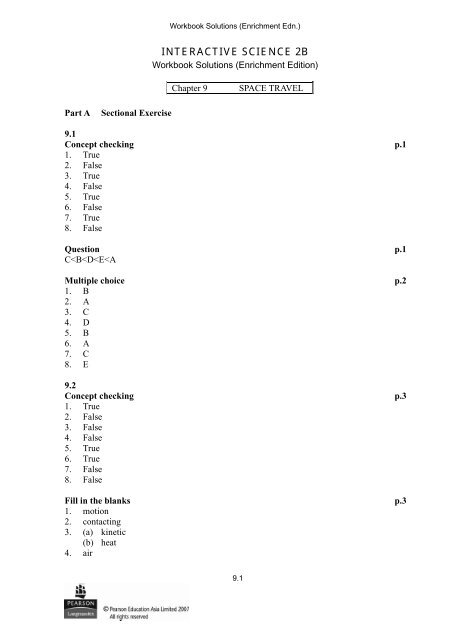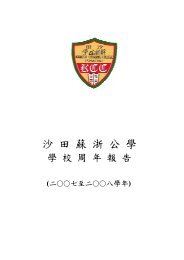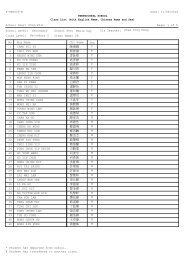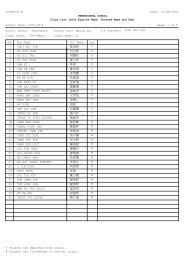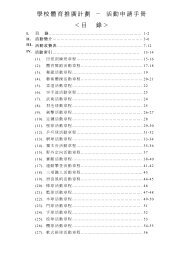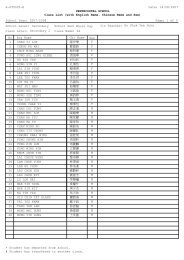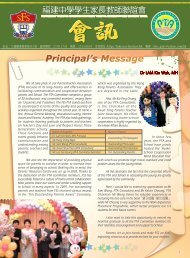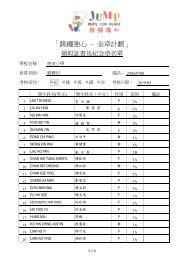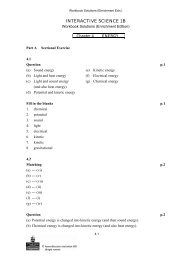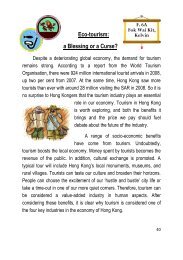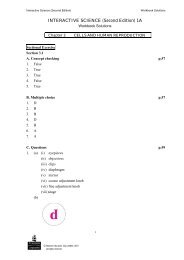INTERACTIVE SCIENCE 2B - Www2.hkedcity.net
INTERACTIVE SCIENCE 2B - Www2.hkedcity.net
INTERACTIVE SCIENCE 2B - Www2.hkedcity.net
Create successful ePaper yourself
Turn your PDF publications into a flip-book with our unique Google optimized e-Paper software.
Workbook Solutions (Enrichment Edn.)<br />
<strong>INTERACTIVE</strong> <strong>SCIENCE</strong> <strong>2B</strong><br />
Workbook Solutions (Enrichment Edition)<br />
Chapter 9<br />
SPACE TRAVEL<br />
Part A<br />
Sectional Exercise<br />
9.1<br />
Concept checking p.1<br />
1. True<br />
2. False<br />
3. True<br />
4. False<br />
5. True<br />
6. False<br />
7. True<br />
8. False<br />
Question p.1<br />
C
Workbook Solutions (Enrichment Edn.)<br />
Question p.4<br />
1. (a) (i) slide (ii) trousers of the child<br />
hindrance / reduced / Wear trousers made of a smoother material.<br />
(b) (i) shoes (ii) track/road<br />
help / increased / Wear shoes with more grooves at the bottom / soles.<br />
(c) (i) wedge (ii) floor/door<br />
help / increased / Use a heavier wedge or a wedge with more grooves at the bottom.<br />
2. game: air hockey (or other reasonable answers)<br />
sport: ice-skating, skiing (or other reasonable answers)<br />
9.3<br />
Concept checking p.5<br />
1. False<br />
2. False<br />
3. True<br />
4. False<br />
5. True<br />
6. False<br />
7. True<br />
8. False<br />
Fill in the blanks p.5<br />
1. (a) Mag<strong>net</strong>ic (b) force of gravity<br />
2. downloads<br />
3. (a) force (b) newton<br />
4. (a) 15 (b) 150<br />
5. matter<br />
9.4<br />
Concept checking p.6<br />
1. True<br />
2. False<br />
3. False<br />
4. False<br />
5. True<br />
6. False<br />
7. True<br />
8. False<br />
Fill in the blanks p.6<br />
(a) reaction<br />
(b) Fuels<br />
(c) downwards<br />
(d) equal<br />
(e) reaction<br />
(f) rocket<br />
(g) gravity<br />
(h) weightlessness<br />
(i) gravity<br />
9.2
Workbook Solutions (Enrichment Edn.)<br />
(j) friction<br />
(k) high<br />
(l) friction<br />
(m) air/atmosphere<br />
(n) heat<br />
(o) heat-resistant<br />
Questions p.8<br />
1. (a)<br />
(b)<br />
(c)<br />
(d)<br />
9.3
Workbook Solutions (Enrichment Edn.)<br />
2. (a)<br />
(b) The boy will move towards the wall.<br />
3. (i) Fill the balloon with more air.<br />
(ii) Add a lubricant along the string.<br />
(iii) Reduce the weight of the balloon rocket.<br />
(iv) Fix a paper cone on the front part of the balloon.<br />
(any two answers)<br />
9.5<br />
Concept checking p.9<br />
1. False<br />
2. False<br />
3. True<br />
4. True<br />
5. True<br />
6. False<br />
Questions p.10<br />
1. (i) strong ultraviolet radiation from the Sun<br />
(ii) extremely high or low temperature<br />
(iii) extremely low gas pressure (or other reasonable answers)<br />
2. (i) Both of them are made of poor conductors of heat. This reduces heat entering or<br />
leaving the by conduction.<br />
(ii) Both of them have shiny surfaces to reflect heat radiation. This reduces heat<br />
entering or leaving them by radiation. (or other reasonable answers)<br />
9.4
Workbook Solutions (Enrichment Edn.)<br />
3. • scratch-resistant lenses<br />
• joysticks<br />
• specially-designed ski boots<br />
(or other reasonable answers, ref. to http://www.seds.org/technology.spinoffs.shtml)<br />
4. Advantages: (i) It is helpful in the development of new materials and technologies.<br />
(ii) It increases our knowledge of the universe.<br />
(iii) Ordinary people may travel in space in the future.<br />
Disadvantages: (i) It wastes time and money.<br />
(ii) Failures of space exploration programmes may cause death and<br />
loss of expensive equipment.<br />
(iii) New technologies may be used in wars.<br />
(or other reasonable answers)<br />
Part B Integrated Exercise<br />
Concept checking p.11<br />
1. True<br />
9. False<br />
2. True<br />
10. False<br />
3. True<br />
11. False<br />
4. False<br />
12. False<br />
5. False<br />
13. True<br />
6. True<br />
14. False<br />
7. True<br />
15. True<br />
8. True<br />
Multiple choice p.11<br />
1. D<br />
10. D<br />
2. C<br />
11. C<br />
3. B<br />
12. C<br />
4. B<br />
13. C<br />
5. C<br />
14. D<br />
6. D<br />
15. D<br />
7. D<br />
16. C<br />
8. A<br />
17. B<br />
9. B<br />
18. D<br />
Questions p.16<br />
1. (a) 2 kg<br />
(b) Mass on the Moon = 2 kg<br />
Weight on the Moon = 20 N/6 = 3.33 N<br />
2. The Moon has no atmosphere surrounding it. No heat is produced due to friction when<br />
the space module lands on the Moon.<br />
3.<br />
9.5
Workbook Solutions (Enrichment Edn.)<br />
4. (a) 7 2 N = 14 N<br />
(b) 6 <br />
<br />
<br />
5. (a) There are many small holes on the surface of the table. Air is pumped out from<br />
these holes and a cushion of air is formed. This reduces the friction between the<br />
table and the puck.<br />
(b) Use a smooth table (or plastic table) without holes. Put some oil/detergent onto the<br />
surface of the table to reduce friction./ Add ball-bearings at the bottom of the puck<br />
to make it roll smoothly. (or other reasonable answers)<br />
6. (a)<br />
(b) Mag<strong>net</strong>ic force and force of gravity<br />
(c) (i) --- (vi)<br />
9.6
Workbook Solutions (Enrichment Edn.)<br />
7. (a)<br />
(ii) --- (iv)<br />
(iii) --- (v)<br />
Letter<br />
representing<br />
the force<br />
A<br />
D<br />
B<br />
E<br />
F<br />
Description of the force<br />
friction exerting on the trolley by the ground<br />
friction exerting on the boy by the ground<br />
pulling force exerting on the trolley by the boy<br />
friction exerting on the ground by the trolley<br />
friction exerting on the ground by the boy<br />
C reaction force exerting on the boy by the trolley<br />
(b) Forces A and E are equal in size because they are a pair of action and reaction<br />
forces. They are acting in opposite directions.<br />
(c) When force B is greater than force A, the trolley will start moving.<br />
(d) • Force A and force E<br />
• Force B and force C<br />
• Force D and force F<br />
8. (i) When Stephen is on the surface of a pla<strong>net</strong>, his weight will not be zero. His weight<br />
may be more than or less than that on the Earth. It depends on the amount of force<br />
of gravity of the pla<strong>net</strong>.<br />
(ii) The foods for astronauts are completely different from those on the Earth. They are<br />
not as delicious as those he normally eats.<br />
(iii) After living in a weightless environment for a period of time, the muscles of<br />
astronauts will relax. When they return to the Earth, they may not even be able to<br />
stand up due to the force of gravity of the Earth. So, astronauts have to keep doing<br />
physical exercise on a daily basis to maintain their muscles in good condition.<br />
Part C Concept Map p.22<br />
1. start<br />
9. heat<br />
2. direction<br />
10. space<br />
3. shape<br />
11. lubricant<br />
4. action, reaction<br />
12. ball<br />
5. equal<br />
13. non-contact forces<br />
6. opposite<br />
14. mass<br />
7. friction<br />
15. weight<br />
8. motion<br />
Part D Reading Comprehension p.25<br />
(a) The force of gravity of the Earth<br />
(b) • Used rocket stages<br />
• Abandoned satellites<br />
• Unwanted spacecraft parts<br />
• Solid fuel debris<br />
• Debris formed after collisions<br />
9.7
Workbook Solutions (Enrichment Edn.)<br />
(c) A pea-sized piece of debris may pe<strong>net</strong>rate a spacecraft. If this happens on a critical<br />
component, such as the flight computer or fuel tank, it could be fatal.<br />
(or other reasonable answers)<br />
(d) If they fall back to the Earth, most of them will burn completely within the atmosphere.<br />
Few of them will pass through the atmosphere. Those that do are likely to fall into the<br />
sea or places of very low population. So the chance of being hit is extremely low.<br />
(e) (i) Use a space shuttle instead of a spacecraft to reduce the use of rocket stages (used<br />
rocket stages are one of the main parts of space junk).<br />
(ii) Do not launch rockets or space shuttles into space until the technology is well<br />
developed. (or other reasonable answers)<br />
Part E Little Einstein’s Corner p.26<br />
(a) (i) Friction and air resistance<br />
(ii) There is no contact between the train and the guideway, so friction is minimised. In<br />
addition, the train has a streamlined design to minimise air friction.<br />
(b) Non-contact force<br />
(c) (i) Because the train floats along the guideway without contact, there is no need for<br />
any wheels. As a result, maintenance of moving parts is not necessary and the rails<br />
need little maintenance.<br />
(ii) Since maglev trains float, there is no friction. The trains can travel at very high<br />
speed.<br />
(iii) Since maglev trains float, no wheels are rolling along the rails and hence little<br />
noise is produced. (or other reasonable answers)<br />
(d) No. Hong Kong is a small city and the journeys are of short distances. Maglev trains<br />
would have to slow down and stop at a station before a high speed is reached. (or other<br />
reasonable answers)<br />
9.8


